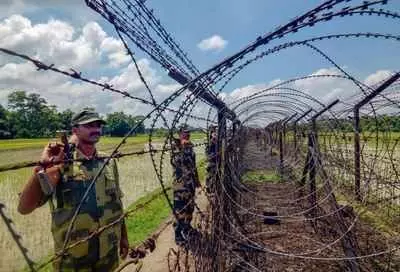Dividing lives

The recent resolutions passed by the Mizoram and Nagaland Assemblies against the Union government's decision to fence the India-Myanmar border and suspend the Free Movement Regime (FMR) cannot be discarded as insignificant roadblocks; they are, in fact, emblematic of a critical concern towards the preservation of history, culture, and connectivity in the region. The decision to suspend the FMR and erect fences along the border appear to have been prompted by security concerns like illegal migration, smuggling, and extremist activities. However, the ramifications of such actions go beyond the realm of security. The India-Myanmar border isn't just a line on the map; it has been a witness to centuries-old relationships, shared cultural heritage, and interconnected livelihoods.
The local and state leaders of concerned northeastern states have firmly asserted that historically, borders drawn arbitrarily have divided people of the same ethnicity and culture without their consent. The treaties that delineated these borders are based on parameters that failed to consider the complex social fabric and historical ties of indigenous communities straddling them. It is a common knowledge that The resolutions passed by Mizoram and Nagaland echo the voices of these communities asserting their right to live together and maintain their ancestral linkages without artificial barriers. In Mizoram, the resolution emphasises the concerns of the Mizo-Chin people, who share strong ethnic ties across the border and have for long nurtured the “dream of reunification”. The proposed fencing threatens to divide not just land but families and communities with intertwined histories. Similarly, in Nagaland, the resolution highlights the disruptive impact of fencing on the age-old ties of the Naga people living on both sides of the border. Moreover, the Free Movement Regime has not just been a convenience but a lifeline for border communities. It facilitates trade, commerce, social interactions, cultural exchanges, and traditional practices. Suspending this regime would not only cause practical hardships but also sever vital linkages that have sustained harmony between these communities for generations.
Nevertheless, the compelling factors that have led to the government’s decision to fence the borders cannot be overlooked altogether. The decision to fence the border in the northeastern Indian states of Arunachal Pradesh, Nagaland, Manipur, and Mizoram is influenced by two significant developments. Firstly, the escalation of conflict in Myanmar following the military coup in February 2021 has led to the displacement of approximately two million people, heightening risks for Indian interests. Secondly, ethnic violence stemming from an affirmative action dispute erupted in Manipur, which shares a border of nearly 400 km with Myanmar. It has resulted in clashes between the Meitei majority and tribal Kuki minority — resulting in over 170 fatalities and displacing tens of thousands of individuals. This, in a way, calls for border security measures.
Still, while the violence and displacement in the state are grave concerns, attributing them solely to the free movement of people across the border oversimplifies the issue. Moreover, the success of fencing in the rugged terrain remains an ambiguous prospect. It's imperative for the Union government to reconsider its decision and engage in meaningful consultations with local communities, state governments, and relevant stakeholders. Any policy affecting the India-Myanmar border must be guided by strong understanding of the region's history, culture, and socio-economic dynamics. Instead of erecting physical barriers, efforts should focus on enhancing cooperation, building trust, and promoting sustainable development initiatives that benefit all border communities.



